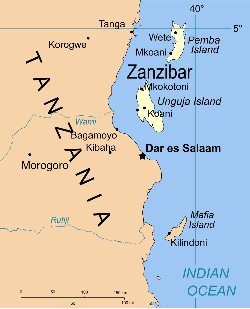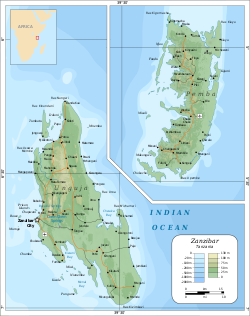
Back Zanzibar Afrikaans ዛንዚባር Amharic Menuþias ANG जांजीबार ANP زنجبار Arabic زنجبار ARZ Zanzíbar AST Zənzibar Azerbaijani Занзибар Bashkir Zanzibar BAN
Zanzibar | |
|---|---|
| Anthem: Mungu ibariki Afrika (Swahili) "God Bless Africa"[1] | |
 Location of Zanzibar within Tanzania | |
 | |
| Status | Semi-autonomous region of Tanzania |
| Capital | Zanzibar City |
| Official languages | |
| Ethnic groups | |
| Religion |
|
| Demonym(s) | Zanzibari |
| Government | Federacy |
| Hussein Mwinyi | |
| Othman Masoud Sharif | |
| Hemed Suleiman Abdalla | |
| Legislature | House of Representatives |
| Establishment history | |
| 10 December 1963 | |
| 12 January 1964 | |
• Unification of Tanganyika and Zanzibar | 26 April 1964 |
| Area | |
• Total[3] | 2,462 km2 (951 sq mi) |
| Population | |
• 2022 census | 1,889,773 |
• Density | 768.2/km2 (1,989.6/sq mi) |
| GDP (nominal) | 2020 estimate |
• Total | $3.75 billion[4] |
• Per capita | $2,500 |
| HDI (2020) | 0.720[5] high |
| Currency | Tanzanian shilling (TZS) |
| Time zone | UTC+3 (EAT) |
| Drives on | Left |
| Calling code | +255 |
| Internet TLD | .tz |
Zanzibar[a] is an insular semi-autonomous region which united with Tanganyika in 1964 to form the United Republic of Tanzania. It is an archipelago in the Indian Ocean, 25–50 km (16–31 mi) off the coast of the African mainland, and consists of many small islands and two large ones: Unguja (the main island, referred to informally as Zanzibar) and Pemba Island. The capital is Zanzibar City, located on the island of Unguja. Its historic centre, Stone Town, is a World Heritage Site.
Zanzibar's main industries are spices, raffia, and tourism.[6] The main spices produced are clove, nutmeg, cinnamon, coconut, and black pepper. The Zanzibar Archipelago, together with Tanzania's Mafia Island, are sometimes referred to locally as the "Spice Islands". Tourism in Zanzibar is a more recent activity, driven by government promotion that caused an increase from 19,000 tourists in 1985,[7] to 376,000 in 2016.[8] The islands are accessible via 5 ports and the Abeid Amani Karume International Airport, which can serve up to 1.5 million passengers per year.[9]
Zanzibar's marine ecosystem is an important part of the economy for fishing and algaculture and contains important marine ecosystems that act as fish nurseries for Indian Ocean fish populations. Moreover, the land ecosystem is the home of the endemic Zanzibar red colobus, the Zanzibar servaline genet, and the extinct or rare Zanzibar leopard.[10][11] Pressure from the tourist industry and fishing as well as larger threats such as sea level rise caused by climate change are creating increasing environmental concerns throughout the region.[12]
- ^ Kendall, David (2014). "Zanzibar". nationalanthems.info. Archived from the original on 4 October 2019. Retrieved 29 January 2015.
- ^ "President's Office and Chairman of Revolutionary Council, Zanzibar". President of Zanzibar. Archived from the original on 1 November 2020. Retrieved 20 December 2020.
- ^ "Country Profile Area and Population". Embassy of the United Republic of Tanzania in Rome. Archived from the original on 18 June 2021. Retrieved 4 June 2021.
- ^ "Gross Domestic Product (GDP) in Zanzibar". www.ushnirs.org. Archived from the original on 16 October 2015. Retrieved 3 July 2014.
- ^ "Sub-national HDI – Area Database – Global Data Lab". hdi.globaldatalab.org. Archived from the original on 23 September 2018. Retrieved 3 December 2018.
- ^ "Exotic Zanzibar and its seafood". 21 May 2011. Archived from the original on 15 August 2011. Retrieved 11 June 2011.
- ^ Lange, Glenn-Marie (1 February 2015). "Tourism in Zanzibar: Incentives for sustainable management of the coastal environment". Ecosystem Services. Marine Economics and Policy related to Ecosystem Services: Lessons from the World's Regional Seas. 11: 5–11. Bibcode:2015EcoSv..11....5L. doi:10.1016/j.ecoser.2014.11.009. ISSN 2212-0416.
- ^ Yussuf, Issa (19 April 2017). "Tanzania: Number of Tourists to Zanzibar Doubles As Tourist Hotels Improve Service Delivery". allAfrica. Archived from the original on 27 August 2017. Retrieved 4 June 2019.
- ^ Cite error: The named reference
:0was invoked but never defined (see the help page). - ^ Li, Joanna (7 June 2018). "Zanzibar Leopard Captured on Camera, Despite Being Declared Extinct". Inside Edition. Archived from the original on 28 August 2018. Retrieved 16 August 2018.
- ^ Seaburn, Paul (12 June 2018). "Extinct 'Evil' Zanzibar Leopard Seen Alive in Tanzania". Mysterious Universe. Archived from the original on 26 June 2019. Retrieved 26 June 2019.
- ^ Khamis, Zakaria A.; Kalliola, Risto; Käyhkö, Niina (15 November 2017). "Geographical characterization of the Zanzibar coastal zone and its management perspectives". Ocean & Coastal Management. 149: 116–134. Bibcode:2017OCM...149..116K. doi:10.1016/j.ocecoaman.2017.10.003. ISSN 0964-5691. Archived from the original on 2 March 2021. Retrieved 12 January 2021.
Cite error: There are <ref group=lower-alpha> tags or {{efn}} templates on this page, but the references will not show without a {{reflist|group=lower-alpha}} template or {{notelist}} template (see the help page).

